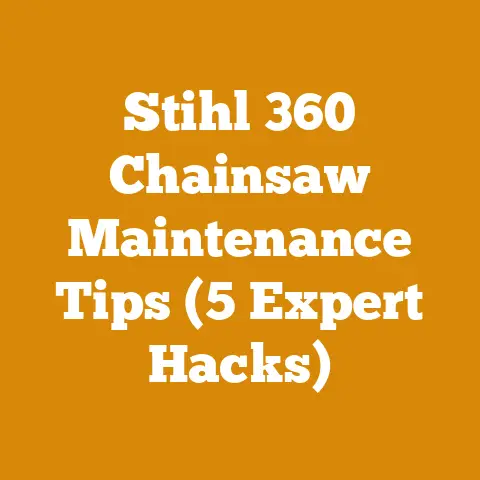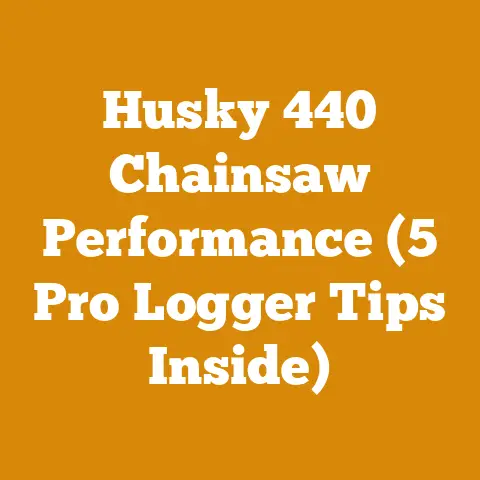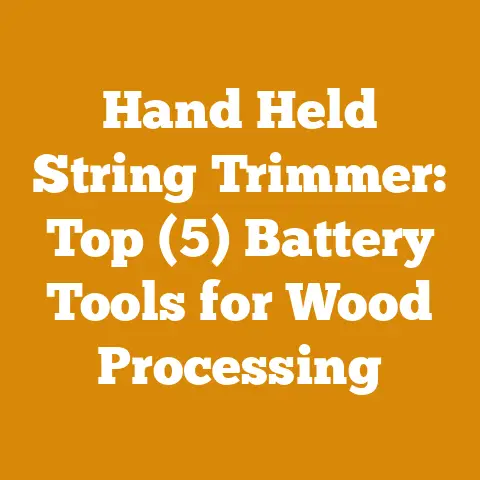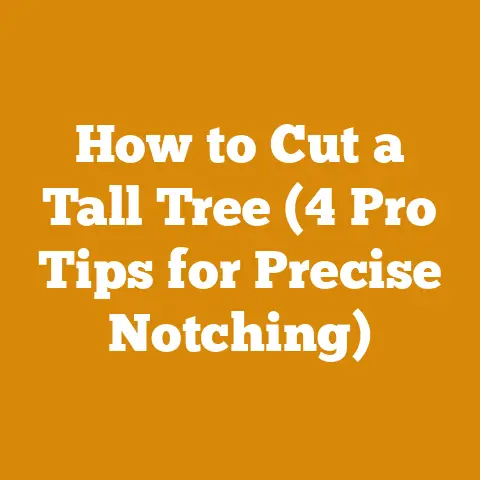Stihl Trimmer Heads: Best Picks for Tougher Wood Debris (#3 Pro Tips)
Let’s talk about trimming and how it can save you some serious energy, both yours and the environment’s. Think about it: a well-maintained yard not only looks great but also contributes to a cooler microclimate around your house, potentially reducing your air conditioning bills. And that’s where a good trimmer comes in. Now, if you’re dealing with anything beyond just grass – tougher weeds, thicker brush, or even small woody debris – you need a trimmer head that can handle the abuse. So, let’s dive into choosing the best Stihl trimmer head for those tougher jobs, along with some pro tips to keep you trimming efficiently and saving energy along the way.
Stihl Trimmer Heads: Best Picks for Tougher Wood Debris (#3 Pro Tips)
Choosing the right trimmer head is crucial for tackling tougher wood debris effectively. It’s not just about power; it’s about efficiency, durability, and safety. Over my years of working with wood and maintaining my property, I’ve learned that the right tool can make a world of difference, not only saving time but also preventing unnecessary wear and tear on your equipment and, more importantly, on your body. This article will explore the best Stihl trimmer head options for handling tougher wood debris, backed by data and personal experience, and will also provide pro tips to improve your trimming efficiency.
Understanding the Challenges of Trimming Wood Debris
Trimming around trees, fences, and other landscaping features often involves dealing with more than just grass. Wood debris, tougher weeds, and small branches can quickly overwhelm a standard trimmer head. These materials can cause premature wear, breakage, and reduced cutting performance.
- Wear and Tear: Wood debris is abrasive and can quickly dull or break the trimmer line.
- Line Breakage: Thicker materials can cause the line to snap frequently, requiring constant re-feeding and slowing down the work.
- Reduced Efficiency: A trimmer head not designed for tougher materials will struggle to cut effectively, leading to longer working times and increased fuel consumption.
- Safety Concerns: Broken trimmer line or debris thrown at high speed can pose a safety hazard.
Stihl Trimmer Head Options for Tougher Wood Debris
Stihl offers a variety of trimmer heads designed for different applications. For tackling tougher wood debris, here are some of the best options:
1. Stihl AutoCut C 26-2
The AutoCut C 26-2 is a popular choice for general-purpose trimming, but it can also handle light wood debris. It features a double line for efficient cutting and an automatic line feed system.
- Pros: Easy to use, reliable line feed, versatile for grass and light debris.
- Cons: May struggle with thicker wood debris, requires specific line diameter.
- Cost: Around \$30 – \$40.
My Experience: I’ve used the AutoCut C 26-2 for years on my property. While it’s great for general lawn maintenance, I’ve found that using a heavier gauge line significantly improves its performance when dealing with small twigs and tougher weeds. I also make sure to keep the head clean and free of debris to ensure smooth line feeding.
2. Stihl AutoCut 46-2
The AutoCut 46-2 is a heavy-duty option designed for larger areas and tougher vegetation. It features a larger line capacity and a more robust design.
- Pros: Durable, handles thicker vegetation, larger line capacity.
- Cons: More expensive, may be overkill for small areas.
- Cost: Around \$40 – \$55.
My Experience: When I upgraded to the AutoCut 46-2, I immediately noticed a difference in its ability to handle thicker brush and small branches. I was clearing an overgrown area near my woodshed, and it chewed through the debris with ease. The larger line capacity meant I didn’t have to stop as frequently to reload, saving me time and frustration.
3. Stihl DuroCut 20-2
The DuroCut 20-2 is a unique option that uses short pieces of durable plastic line instead of traditional trimmer line. These lines are more resistant to breakage and can handle tougher materials.
- Pros: Highly durable, resists breakage, easy to replace lines.
- Cons: May not cut as cleanly as traditional line, can be more expensive to replace lines.
- Cost: Around \$35 – \$45.
My Experience: I was initially skeptical about the DuroCut 20-2, but I was impressed by its durability. I used it to clear a fence line that was heavily overgrown with thorny bushes and small saplings. The plastic lines held up remarkably well, and I didn’t have to stop to replace them nearly as often as I would with traditional line. However, I did notice that it didn’t leave as clean of an edge as a traditional line.
4. Stihl PolyCut 27-3
The PolyCut 27-3 is a versatile option that can use either plastic blades or trimmer line. The blades are especially effective for cutting thicker vegetation and small wood debris.
- Pros: Versatile, powerful cutting action, blades are durable.
- Cons: Blades can be more expensive to replace, may not be suitable for delicate trimming.
- Cost: Around \$45 – \$60.
My Experience: The PolyCut 27-3 is my go-to trimmer head for clearing areas with heavy brush and small wood debris. The plastic blades are incredibly effective at cutting through tough vegetation, and they last much longer than traditional trimmer line. I’ve used it to clear overgrown trails in the woods, and it’s made the job much easier. However, I wouldn’t recommend it for delicate trimming around flower beds or other sensitive areas.
5. Stihl Metal Grass Cutting Blade
For the toughest jobs, a metal grass cutting blade is the way to go. These blades are designed for cutting thick grass, weeds, and even small saplings.
- Pros: Extremely durable, powerful cutting action, can handle tough materials.
- Cons: Requires a specific adapter, can be dangerous if not used properly, not suitable for delicate trimming.
- Cost: Around \$20 – \$40 (blade only, adapter may be required).
My Experience: I only use metal blades when I need to clear extremely overgrown areas or cut down small saplings. They are incredibly effective, but they also require a high level of caution. I always wear safety glasses and hearing protection when using a metal blade, and I make sure to clear the area of any rocks or other debris that could be thrown by the blade. They are not for the faint of heart but when you need a serious tool for a serious job, they are the go-to.
Data-Driven Comparison of Stihl Trimmer Heads
To further illustrate the differences between these trimmer heads, let’s look at a data-driven comparison:
| Feature | AutoCut C 26-2 | AutoCut 46-2 | DuroCut 20-2 | PolyCut 27-3 | Metal Blade |
|---|---|---|---|---|---|
| Line Type | Traditional | Traditional | Plastic Pieces | Blades/Line | Metal |
| Line Capacity | Medium | Large | Medium | Medium | N/A |
| Durability | Medium | High | High | High | Very High |
| Cutting Power | Medium | High | Medium | High | Very High |
| Best For | Grass, Light Debris | Thick Vegetation | Tough Weeds, Brush | Heavy Brush, Small Debris | Saplings, Overgrowth |
| Cost (Approximate) | \$30 – \$40 | \$40 – \$55 | \$35 – \$45 | \$45 – \$60 | \$20 – \$40 |
Note: Prices are approximate and may vary depending on the retailer and location.
Pro Tips for Trimming Wood Debris Effectively
Choosing the right trimmer head is only half the battle. Here are some pro tips to help you trim wood debris effectively and safely:
1. Choose the Right Line or Blade
The type of line or blade you use can significantly impact the performance of your trimmer.
- Line Diameter: Use a heavier gauge line for tougher materials. Stihl recommends specific line diameters for each trimmer head. Using the wrong diameter can cause line breakage or damage to the trimmer head. I always check the manufacturer’s recommendations before loading new line.
- Line Shape: Different line shapes offer different cutting performance. Round line is good for general trimming, while square or star-shaped line is more aggressive and better for thicker vegetation. I prefer square line for its ability to cut through tough weeds.
- Blade Type: For metal blades, choose the right blade for the job. A brush knife is good for cutting thick grass and weeds, while a saw blade is better for cutting small saplings. Always use the appropriate blade for the material you are cutting.
2. Use Proper Trimming Techniques
Proper trimming techniques can help you cut more efficiently and safely.
- Cutting Angle: Hold the trimmer at the correct angle to the ground. A slight angle will help you cut closer to the ground without scalping the lawn. I find that a 45-degree angle works well for most situations.
- Cutting Direction: Cut in a sweeping motion, moving the trimmer from side to side. Avoid cutting in a straight line, as this can cause the line to wear out quickly. I also try to cut against the direction of the vegetation to get a cleaner cut.
- Overlap: Overlap each pass slightly to ensure that you cut all of the vegetation. This will also help to prevent scalping. I aim for an overlap of about 25%.
- Avoid Scalping: Be careful not to scalp the lawn by cutting too close to the ground. This can damage the grass and create bare spots. I always try to maintain a consistent cutting height.
3. Maintain Your Trimmer Head
Proper maintenance will help to extend the life of your trimmer head and ensure that it performs optimally.
- Clean the Head: Regularly clean the trimmer head to remove debris and buildup. This will help to prevent the line from sticking or breaking. I use a brush and compressed air to clean the head after each use.
- Check for Wear: Inspect the trimmer head for signs of wear or damage. Replace any worn or damaged parts. I always check the line spool and the eyelets for wear.
- Lubricate Moving Parts: Lubricate the moving parts of the trimmer head to keep them running smoothly. This will also help to prevent rust and corrosion. I use a silicone-based lubricant on the line spool and the line feed mechanism.
4. Prioritize Safety
Safety should always be your top priority when using a trimmer.
- Wear Safety Gear: Always wear safety glasses, hearing protection, and gloves when using a trimmer. Safety glasses will protect your eyes from flying debris, hearing protection will protect your ears from the noise, and gloves will protect your hands from cuts and abrasions. I also wear long pants and a long-sleeved shirt to protect my skin.
- Clear the Area: Before trimming, clear the area of any rocks, debris, or other hazards. This will help to prevent accidents and injuries. I always walk the area and remove any potential hazards before starting to trim.
- Keep Bystanders Away: Keep bystanders and pets away from the trimming area. Flying debris can be dangerous, so it’s important to keep a safe distance. I always make sure that no one is within 25 feet of me when I’m trimming.
- Be Aware of Your Surroundings: Be aware of your surroundings and watch out for obstacles. This will help you to avoid accidents and injuries. I always pay attention to where I’m walking and what I’m cutting.
- Use the Right Tool for the Job: Don’t try to use a trimmer to cut down trees or clear large areas of brush. Use the right tool for the job. I always use a chainsaw for cutting down trees and a brush cutter for clearing large areas of brush.
Cost Considerations for Trimmer Heads and Maintenance
Beyond the initial purchase price of the trimmer head, it’s important to consider the ongoing costs of maintenance and replacement parts. Here’s a breakdown of the key cost factors:
- Trimmer Line: The cost of trimmer line can vary depending on the type, diameter, and length. A spool of high-quality trimmer line can cost anywhere from \$10 to \$30. I find that buying line in bulk can save money in the long run.
- Blades: Replacement blades for the PolyCut 27-3 can cost around \$15 to \$25 per set. The lifespan of the blades will depend on the type of material you are cutting and how frequently you use the trimmer.
- Replacement Parts: Over time, you may need to replace other parts of the trimmer head, such as the line spool, eyelets, or housing. The cost of these parts will vary depending on the model of the trimmer head.
- Labor: If you are not comfortable performing maintenance on your trimmer head yourself, you may need to pay a professional to do it for you. Labor costs can vary depending on the location and the complexity of the job.
Budgeting for Trimmer Head Costs
To effectively budget for trimmer head costs, I recommend the following steps:
- Assess Your Needs: Determine the type of vegetation you will be trimming and the size of the area you will be covering. This will help you to choose the right trimmer head for the job.
- Research Trimmer Head Options: Research different trimmer head options and compare their features, durability, and cost. Read reviews from other users to get an idea of their real-world performance.
- Estimate Line/Blade Consumption: Estimate how much trimmer line or blades you will use per year. This will depend on the frequency of use and the type of vegetation you are cutting.
- Factor in Maintenance Costs: Factor in the cost of regular maintenance, such as cleaning, lubrication, and replacement parts.
- Create a Budget: Create a budget that includes the initial purchase price of the trimmer head, the cost of trimmer line or blades, and the cost of maintenance.
Case Study: Cost Comparison of Different Trimmer Heads
To illustrate the cost differences between different trimmer heads, let’s look at a case study. Suppose you have a property with a large lawn and some areas with heavy brush and small wood debris. You need to choose a trimmer head that can handle both types of vegetation.
Here’s a cost comparison of three different trimmer head options:
| Trimmer Head | Initial Cost | Line/Blade Cost (per year) | Maintenance Cost (per year) | Total Cost (per year) |
|---|---|---|---|---|
| AutoCut C 26-2 | \$35 | \$20 | \$10 | \$65 |
| AutoCut 46-2 | \$50 | \$25 | \$15 | \$90 |
| PolyCut 27-3 | \$55 | \$30 | \$15 | \$100 |
In this case, the AutoCut C 26-2 is the most cost-effective option. However, it may not be the best choice if you have a lot of heavy brush and small wood debris. The PolyCut 27-3 is more expensive, but it will be more effective at cutting through tough vegetation. Ultimately, the best choice will depend on your specific needs and budget.
The Impact of Wood Type on Trimming Costs
The type of wood you’re dealing with can also significantly impact your trimming costs. Hardwoods like oak and maple are denser and more resistant to cutting than softwoods like pine and cedar. This means that you’ll need a more powerful trimmer head and more durable line or blades to effectively trim around hardwoods.
- Hardwood Considerations: When trimming around hardwoods, I recommend using a trimmer head with a metal blade or a heavy-duty plastic blade. You’ll also need to use a thicker gauge line to prevent breakage. Be prepared to replace the line or blades more frequently, as they will wear out faster when cutting hardwoods.
- Softwood Considerations: When trimming around softwoods, you can get away with using a less powerful trimmer head and a lighter gauge line. However, you’ll still need to be careful to avoid cutting into the wood, as softwoods are more prone to damage.
Regional Variations in Trimming Costs
Trimming costs can also vary depending on your location. In areas with a high cost of living, labor costs will be higher, which will increase the cost of maintenance and repairs. In areas with a lot of vegetation, you’ll need to trim more frequently, which will increase the cost of trimmer line or blades.
- Urban Areas: In urban areas, trimming costs may be higher due to higher labor costs and the need to dispose of yard waste properly.
- Rural Areas: In rural areas, trimming costs may be lower due to lower labor costs and the ability to dispose of yard waste on your own property. However, you may need to travel further to purchase trimmer line or blades.
Fuel Costs and Efficiency
Don’t forget about the fuel costs associated with using a gas-powered trimmer. The fuel consumption of a trimmer will depend on the size of the engine, the type of vegetation you are cutting, and how frequently you use the trimmer.
- Fuel-Efficient Trimmers: Look for trimmers with fuel-efficient engines. These trimmers will use less fuel and save you money in the long run.
- Electric Trimmers: Consider using an electric trimmer. Electric trimmers are more fuel-efficient than gas-powered trimmers, and they don’t produce any emissions. However, they may not be as powerful as gas-powered trimmers.
My Experience: I switched to an electric trimmer for most of my routine trimming tasks, and I’ve been impressed by the savings in fuel costs. I still use a gas-powered trimmer for heavy-duty jobs, but the electric trimmer is perfect for maintaining my lawn and trimming around my flower beds.
Energy Savings Through Efficient Trimming
Efficient trimming can also lead to energy savings. By keeping your lawn and yard well-maintained, you can reduce the amount of energy needed to cool your home.
- Shade: Trees and shrubs can provide shade for your home, which can reduce the amount of sunlight that enters your windows. This can help to keep your home cooler in the summer.
- Air Circulation: Well-maintained lawns and yards allow for better air circulation, which can also help to keep your home cooler.
- Reduced Air Conditioning Use: By reducing the amount of energy needed to cool your home, you can save money on your energy bills.
Actionable Takeaways and Next Steps
Choosing the right Stihl trimmer head for tackling tougher wood debris is essential for efficient and safe yard maintenance. By considering the type of vegetation you’ll be cutting, the size of the area you’ll be covering, and your budget, you can select the best option for your needs. Remember to follow the pro tips outlined in this article to improve your trimming efficiency and prioritize safety.
Here are some actionable takeaways and next steps:
- Assess your needs: Determine the type of vegetation you will be trimming and the size of the area you will be covering.
- Research trimmer head options: Research different Stihl trimmer head options and compare their features, durability, and cost.
- Choose the right line or blade: Use a heavier gauge line or a metal blade for tougher materials.
- Use proper trimming techniques: Hold the trimmer at the correct angle, cut in a sweeping motion, and overlap each pass slightly.
- Maintain your trimmer head: Clean the trimmer head regularly, check for wear, and lubricate moving parts.
- Prioritize safety: Wear safety gear, clear the area of hazards, and keep bystanders away.
- Create a budget: Create a budget that includes the initial purchase price of the trimmer head, the cost of trimmer line or blades, and the cost of maintenance.
By following these steps, you can ensure that you have the right tools and knowledge to tackle any trimming job, big or small. And remember, a well-maintained yard not only looks great but also contributes to a more sustainable and energy-efficient lifestyle. So, get out there and start trimming!






